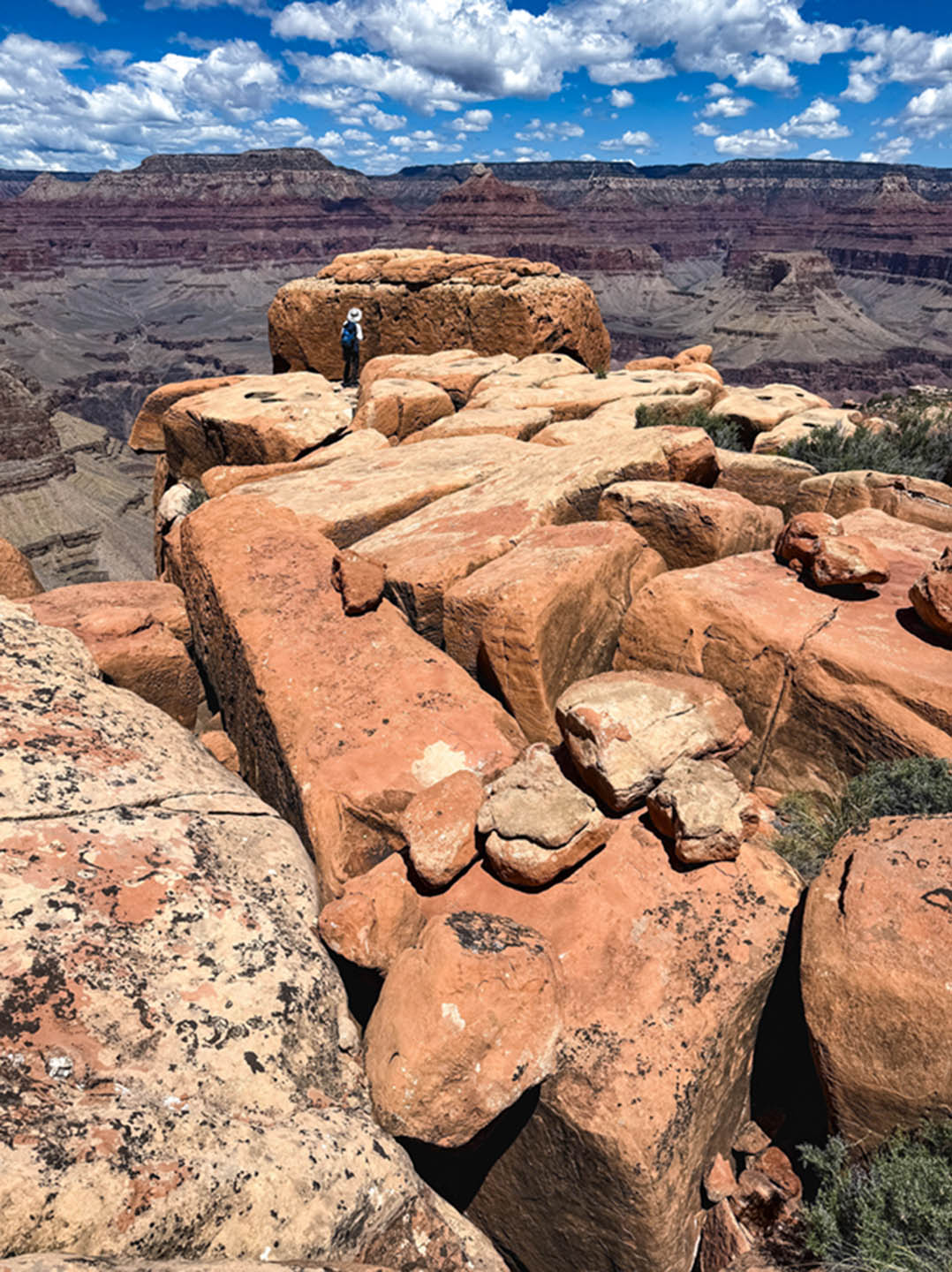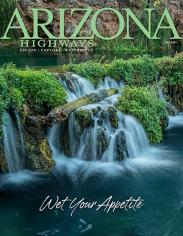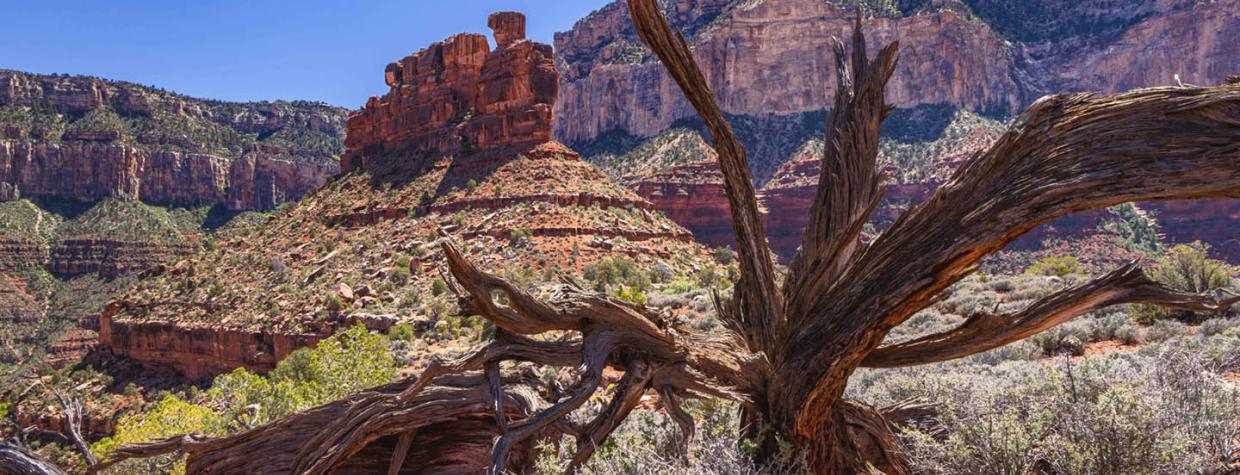Perhaps I should’ve charted safer courses years ago. But here I am, closer to my 70s than my 50s, still chasing improbable dreams. This time, with one particularly stubborn idea: to climb The Battleship, a 5,850-foot summit in the Grand Canyon.
These days, as a Medicare cardholder getting AARP discounts, I mostly experience the Canyon as a tour guide — day trips from Sedona, paved paths, interpretive stories. The overnight backpacking epics to Thunder River and Royal Arch Canyon have mostly sailed.
I feel taunted by my disappearing delusions of youth for certain Grand Canyon pursuits — especially the unruly, off-trail sort that demand route-finding and a willingness to scramble skyward. But I still feel the pull when something unresolved beckons.
For decades, I’ve passed The Battleship — a massive sandstone formation far below the South Rim — on countless hikes along the Bright Angel Trail. It rises in full view of El Tovar and Kolb Studio, a striking outcrop perched defiantly in the depths.
From Powell Point, its silhouette catches the last light of day, burning crimson at sunset. Most visitors snap a photo from the rim and move on. But I’d heard whispers of a hidden way to the top — unmarked, unmaintained, but navigable.
So, I invited my hiking partner Daniel — a retired lawyer with a photographer’s eye — and one morning in early May, we set out from Sedona before sunrise. This shoulder-season window, after spring break but before Memorial Day, offers ideal conditions: cool air, small crowds and vibrant color.
We parked at the Bright Angel Trailhead under a soft blanket of quiet. There’s something rare and sacred about a still Grand Canyon morning, the way sound holds its breath before the world wakes up. Starting at an elevation of 6,850 feet, we passed Kolb Studio — once the family home of a fearless pioneer photographer — and dropped into the Canyon.
The Bright Angel Trail, chiseled into Kaibab Limestone and then Coconino Sandstone, descends through switchbacks and tunnels. The trail was so quiet — like we had reserved the Canyon for only ourselves for a day. We pulled out our cameras and made photos of our destination before tackling more switchbacks. Roughly 2 miles in, after descending more than 1,440 feet, we stepped off the popular trail and into a wilder chapter of our day.
Our objective now lay across tilted slopes of Hermit Shale that slanted awkwardly beneath us, the angle gnawing at aging knees and ankles. Stacked stone cairns — those trail markers built by previous wanderers — became reassuring indicators that we were on course.
We hike off-trail frequently in the wilderness outside Sedona. Finding cairns is not new to us. “Here’s one!” we’d call out as we moved through a maze of cactus, loose soil and sun-bleached boulders. Our route traversed due north along a cliff ledge. The stone stacks often seemed invisible as we lost them in the vast landscape.
Eventually, we reached a windswept saddle connecting us to our destination. For the first time, the magnitude of The Battleship’s ramparts unfurled before us — massive cliffs rising abruptly, defending the summit.
Some call The Battleship one of the easier non-technical summit climbs in Grand Canyon. But “easy” is a generous term in a place that doesn’t tolerate mistakes. The route is classified as Class 3: Scrambling, handholds required for upward movement, and fall consequences serious.
Over the years, I’ve summited my share of Canyon formations — Cheops Pyramid, Escalante Butte, Marion Point and even Shiva Temple, where we bivouacked overnight to reach Claude Birdseye Point the following morning. But I’ve never mistaken this landscape for tame. Here, ambition can distort judgment, and routes are more suggestion than promise.

Trip reports from previous expeditions had described an “improbable” route to the summit hidden on the east side. Hints for how to approach the climb had us starting up an intimidating slope littered with broken rock and migrating soil that flowed down from the cliffs. A way up top seemed more impossible the higher we looked up.
Finally, tucked into the shadows of the cliff base, we found a promising chute that disappeared into a hidden passageway. We scrambled behind the massive block of stone up to a wide ledge. The real route-finding had begun.
We entered another narrow chute up to a landing, and then a long, dark ramp strewn with rubble. The walls tightened around us enough that we could touch both sides. The damp sandstone smelled of earth and minerals, its rough texture under our hands. Then came the crux.
A shaky pile of rocks offered the first boost. The gap, barely 3 feet wide, reached like a chimney toward a tiny opening of sunlight. But halfway up, I was wedged — back against one wall, feet braced on the other, suspended over a 20-foot drop. My pack scraped stone. My breath quickened. Adrenaline hummed like static in my veins.
I reached the top and helped hoist Daniel’s pack. But the hardest move was still ahead.
The next stretch wasn’t technically tougher, but psychologically, it punched harder. A sloping ledge tilted toward a sheer 100-foot drop. Exposure like this changes everything. It’s not just about footing; it’s about focus. I paused. My legs trembled. I considered retreating.
I asked myself the questions that come more frequently with age: Is this still smart? Do I need to prove anything? But the answer, quiet and steady, rose above the noise: You came this far. Just do it.
I locked my eyes on the line, not the void. Four or five steps later, I was over the final rise and onto the summit. Daniel appeared a few minutes behind me — face pale, smile wide. We were both sweating bullets, but we’d made it.
The summit stretches flat and long, a sandstone deck above the abyss. To the south, we could see El Tovar, a wooden turret highlighting its silhouette on the rim. Far below, the Bright Angel Trail lay thin as a strand of hair across the desert floor.
Farther east, a splash of green cottonwoods called out the oasis of Havasupai Gardens — once cultivated by Indigenous people, now a shaded rest stop for hikers halfway to Phantom Ranch at the bottom of the Canyon.
We sat in silence, letting the views soak in. The Canyon doesn’t hand out easy victories, and this one came with no small cost in courage and determination. But what a reward: the solitude, the majestic temples and buttes, the satisfaction of having navigated a route few others even notice, let alone attempt.
Still, I couldn’t shake the next thought: We’re only halfway. That final pitch — the one that nearly undid me — was waiting for us at the start of our descent. My stomach tightened with that old, familiar flicker of nerves. But steadier now. With time, you learn which fears to trust, which ones to breathe through.
The body may ache more now, but the Canyon still calls. And as long as I have the breath to answer, I’ll keep being drawn to those precipices where beauty and risk converge, where the edge sharpens the senses and, for a moment, you feel unmistakably alive.
Back at the rim, we lingered. The Battleship lay below us — no longer distant and mysterious, but a story etched in memory. And although we were done for the day, I could already feel it: the quiet pull of whatever comes next.

